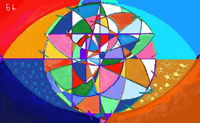Speaker
Dr
Bertalan Juhasz
(Stefan Meyer Institute for Subatomic Physics, Vienna, Austria)
Description
The ground-state hyperfine splitting (GS-HFS) of hydrogen at 1.42 GHz has been measured with an extremely high precision of 10^-12. Thus measuring the GS-HFS of antihydrogen, the antimatter counterpart of hydrogen, would be a stringent test of the CPT symmetry. The ASACUSA collaboration at CERN's Antiproton Decelerator (AD) is preparing such an experiment using an atomic beam apparatus [1,2] similar to the ones which were used in the early days of hydrogen HFS spectroscopy. The apparatus will use antihydrogen atoms produced in a superconducting cusp trap (i.e. anti-Helmholtz coils). The inhomogeneous magnetic field of such a trap will create a partially polarized beam, which will then pass through a radiofrequency resonator to flip the spin of the antihydrogen atoms. Finally a sextupole magnet analyses the spin orientation of the atoms. Simulations showed that such an experiment is feasible if appr. 100 antihydrogen atoms per second can be produced in the ground state, and that an accuracy of appr. 10^-7 can be reached within reasonable measuring times [2].
This precision might seem to be small compared to the often-quoted "most precise CPT test" of 10^-18 between the masses of the neutral kaon and antikaon. However, V.A. Kostelecky and his colleagues created an extension to the standard model by introducing parameters into its Lagrangian which violate either the CPT symmetry or the Lorentz invariance [3]. These parameters have a dimension of energy (or mass or frequency), therefore their model claim that it is not the relative but the absolute precision of a measurement which matters when doing a CPT test. Thus by measuring a relatively small quantity on the energy scale (like the 1.42 GHz antihydrogen GS-HFS), a smaller relative accuracy is needed to reach the same absolute precision. Therefore a measurement of the GS-HFS frequency with a relative precision of only 10^-5 would already surpass the absolute precision of the kaon-antikaon mass comparison.
[1] ASACUSA collaboration, Proposal CERN-SPSC 2005-002, SPSC P-307 Add. 1, 2005.
[2] B. Juhasz, E. Widmann, Hyp. Int. 193 (2009) 305.
[3] R. Bluhm, V.A. Kostelecky, N. Russell, Phys. Rev. Lett. 82 (1999) 2254.
Author
Dr
Bertalan Juhasz
(Stefan Meyer Institute for Subatomic Physics, Vienna, Austria)
Co-author
Prof.
Eberhard Widmann
(Stefan Meyer Institute for Subatomic Physics, Vienna, Austria)

